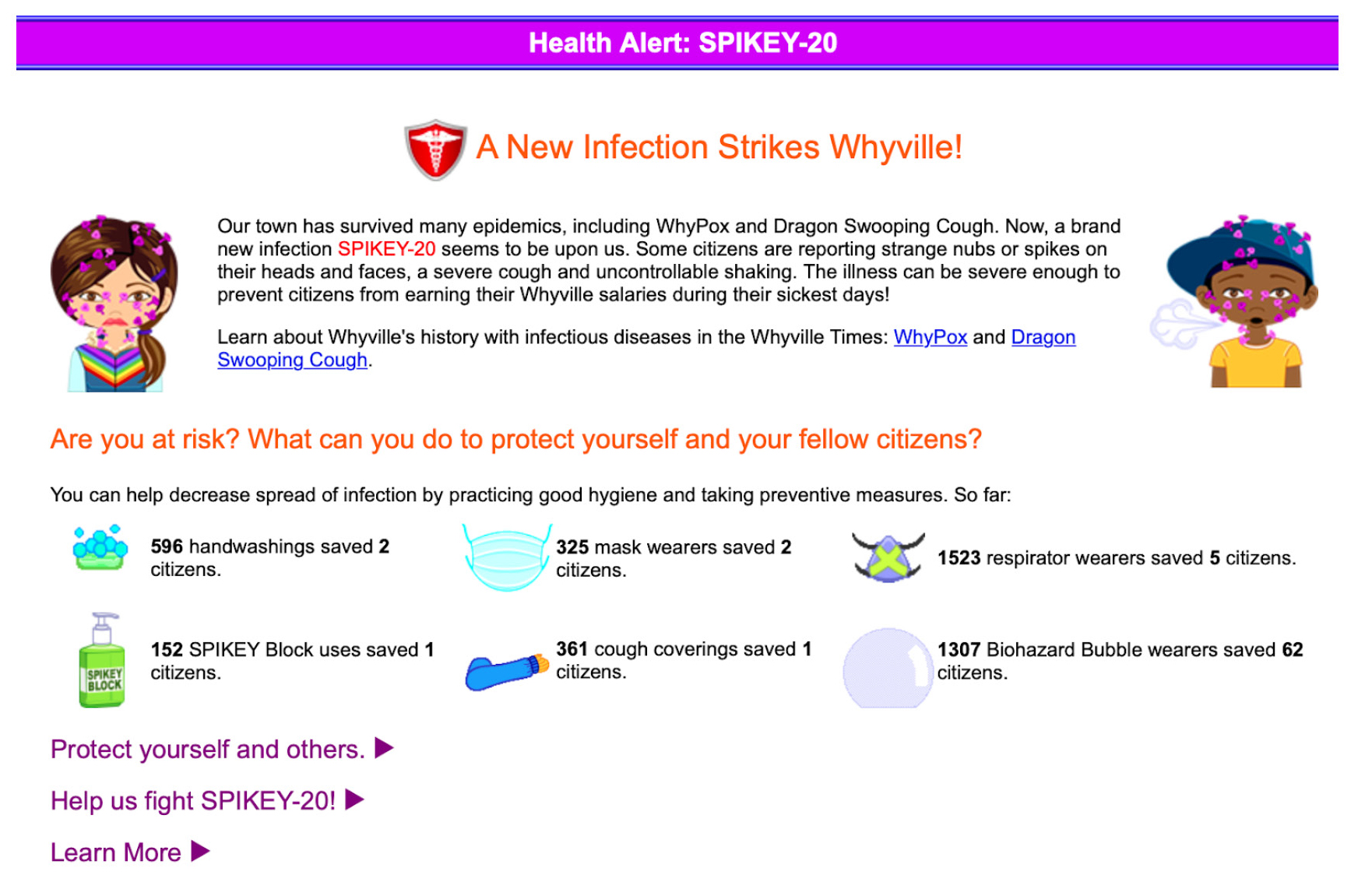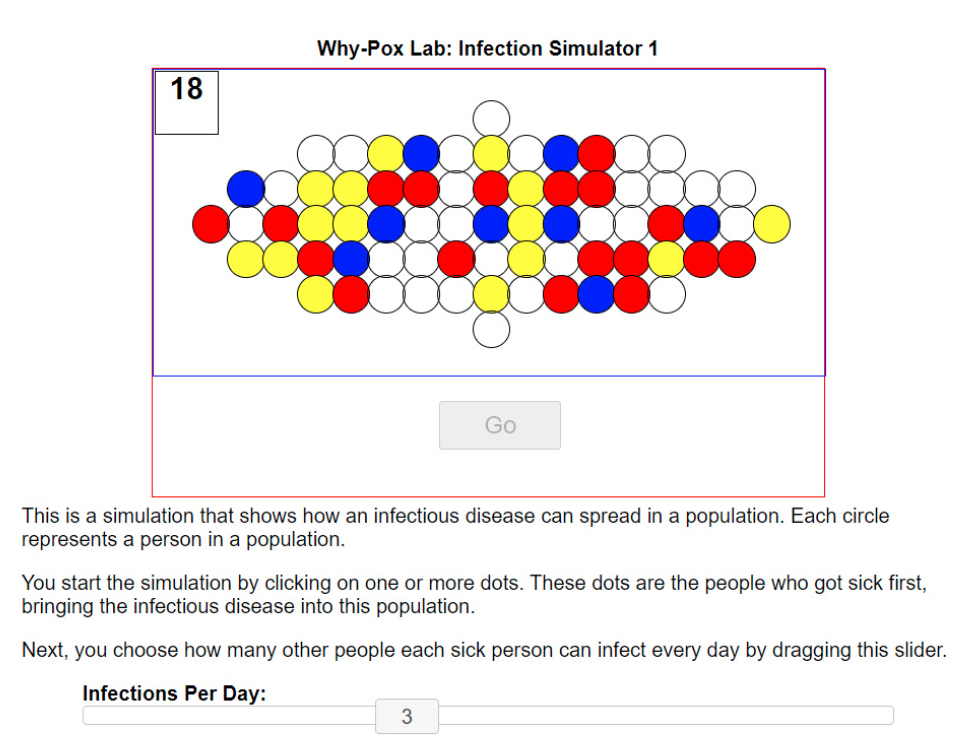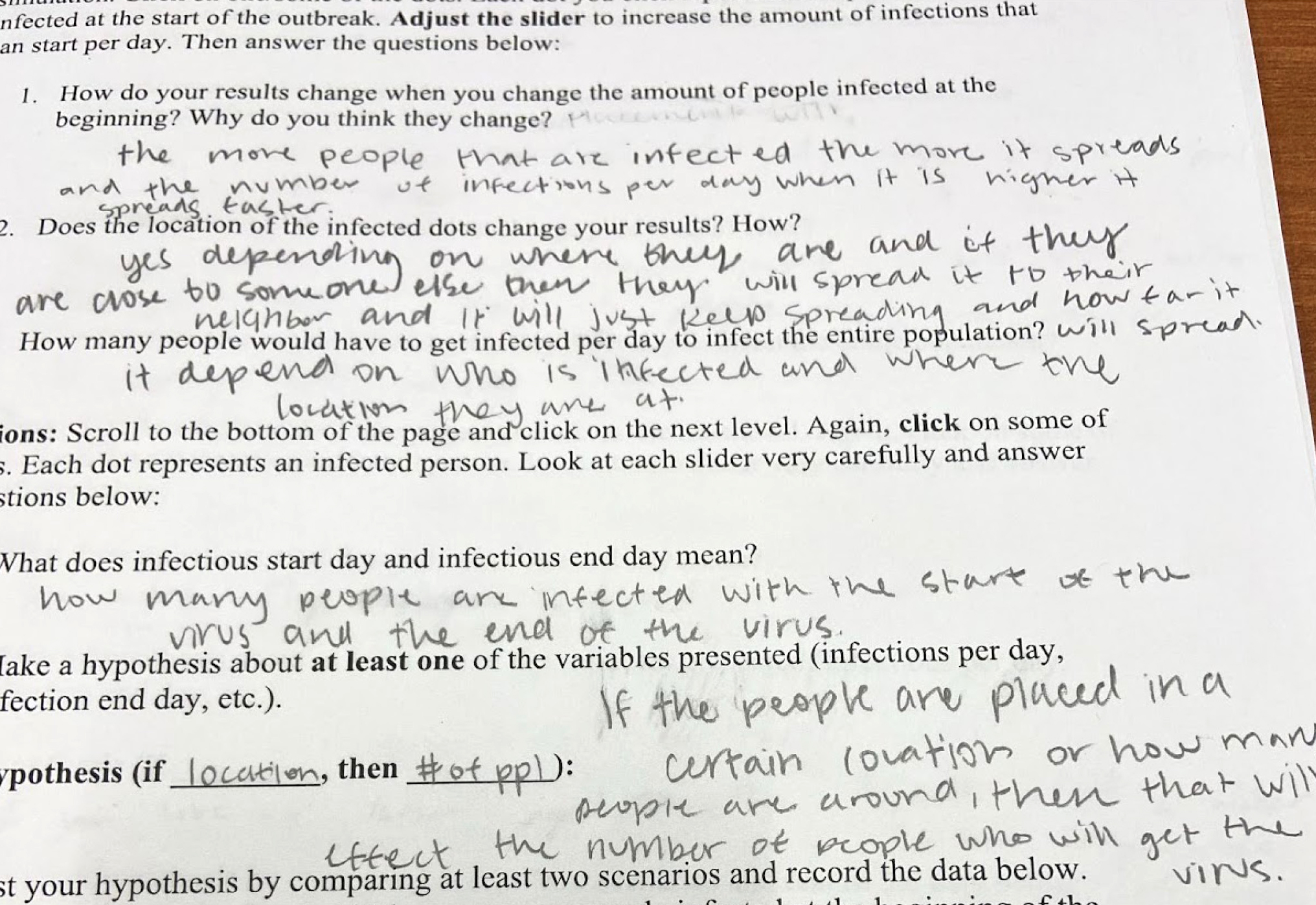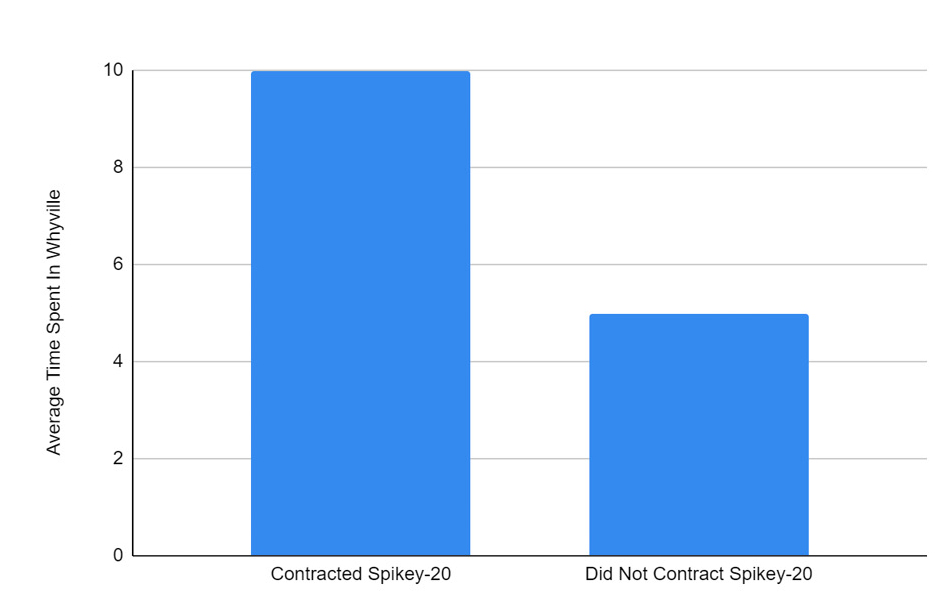special issue
Immersive Learning Through Experiential Inquiry of a Virtual Epidemic
The Curricular Unit of SPIKEY-20
The Science Teacher—January/February 2023 (Volume 90, Issue 3)
By Tyler Hansen, Deborah Fields, Amanda Strawhacker, and Yasmin Kafaiy

Our world has changed dramatically due to the COVID-19 pandemic, including making the instruction of viral life cycles, disease transmission, and health effects sensitive and even contested subjects. Here we share one approach to bring students into a colorful, virtual experience of an epidemic that was simultaneously playful and safe, allowing them to actively inquire and learn about the science of epidemiology while connecting virtual infection experiences to real-life familiarity with COVID-19.
As this special issue describes, there are three dimensions to epidemiologic education (Straif-Bourgeois et al. 2014). Biology of disease covers how viruses infect, replicate, and cause disease within an individual. Epidemiology of disease focuses on viral periods (e.g., incubation and latent periods) and person-to-person contagion. Finally, infectious disease epidemiology concerns population-level factors of epidemic spread and impact within and on communities. Throughout this article, we refer to these epidemiologic dimensions as level 1, level 2, and level 3, respectively.
Although aspects of these levels of epidemiology are sometimes explored in classrooms, such as the biology of disease or how diseases spread through populations, it is rare that students investigate all of them together. The curriculum shared here provides students with an opportunity to learn about all levels of epidemiology through direct inquiry of personal experiences of infection in the virtual world of Whyville, combined with community reflection and comparison to real-life epidemic experiences.
By removing students from the ever-real threat of COVID-19 and bringing them into an immersive, virtual epidemic experience, students explored epidemiology topics freely with little anxiety. Their final reflective writing pieces demonstrate the rich connections students made between virtual and real epidemics.
Unit description
The curriculum explores three levels of epidemiology through eight lesson plans applicable at any secondary grade level (some elementary teachers have even used it). It begins with the cellular components of viruses and vaccines, then shifts to inquiry-based learning of the role of viral periods in individual and societal spread, and finally focuses on how epidemiology impacts communities, including issues of equity. The unit also supports literacy in scientific topics, data visualization, modeling, and personal connections with scientific topics. The broad nature of this curriculum allows for adaptation and into various life science units.
The first author situated this curriculum in the cell biology unit of an AP biology course after cell organelles, which provided a smooth transition to learning about how viruses hijack cellular functions. However, there are a variety of contexts in which this curriculum can be taught. Biology classes that follow the NGSS can use this curriculum when learning cellular processes and biological hierarchies.
Immersive simulation: The virtual world of Whyville
Whyville is an educational website created in 1999 for children to explore a variety of science topics. Within the online virtual world, with more than 8.4 million registered players, students create avatars (virtual characters) and engage with hundreds of educational games. A living community, “Whyvillians” spend time with one another communicating via cartoonlike chat bubbles (see Figure 1), creating virtual “face parts” for purchase, and earning “clams,” Whyville’s currency. With clams, players can purchase new face parts for their avatars, along with personal protective equipment (PPE) and other virtual goods. Whyville contains its own public institutions, such as a Center for Disease Control (CDC) and even a citizen-written newspaper, The Whyville Times. Thus, Whyville promotes both learning and civic engagement throughout the virtual world.

Whyville chat bubbles.
Since 2002, Whyville’s creators have released virtual diseases onto the Whyvillian population to mirror real epidemics (e.g., ebola, the flu.) where players’ actions can reduce or magnify spread. In light of the COVID-19 pandemic, the creators of Whyville released a new disease in 2020 called SPIKEY-20 (see Fields et al. 2022). Players that contracted the disease displayed red spikes, coughed in their chat bubbles, and shook violently. The Whyville CDC advised citizens to protect one another by washing hands and wearing PPE, which varied by cost and effectiveness (see Figure 2). Free testing and updated infection statistics at the CDC informed player action.

Whyville virus alert and list of precautions to take.
Curriculum
The 10-day, eight-lesson curriculum (see Table 1) that we designed brings together many elements of epidemic education that students rarely experience together: cellular level biology, person-to-person infectious spread (vitally including an asymptomatic infectious period), societal-level effects on infectious spread, data science use, infection simulations, and personal reflections on epidemiology, all through individual and classroom inquiry. In the following sections we describe features of the unit. Table 2 (see Online Connections) shows the science standards this unit meets.

Unit Outline
Virtual world immersion
The unit begins with immersion into the virtual world of Whyville so that students have some investment in their avatars, game activities, and the virtual community before the epidemic. We recommend at least one day in class or at home to create avatars and play games in Whyville.
Biology of disease
Following immersion in Whyville, the unit begins with the smallest component in an epidemic: cells and biological hierarchies. The first lesson concerns how viruses infiltrate cells and use their molecular machinery to propagate. Starting this lesson directly after teaching cells is an effective strategy, as students apply what they already know about cell organelles in a novel and relevant manner. After discussing what students already know about viruses with a know, want to know, and learned (KWL) chart, students watch an animation about viral cellular reproduction before collaboratively reviewing what they already knew and what they learned. While implementing this, I found that my students already knew quite a bit about viruses and their life cycles. Students move into specifics of viral anatomy by creating models of different viruses, noting various anatomical structures, comparing one another’s models, and finally making predictions about the functions of these structures (see Figure 3). Teachers can use this introduction to guide their implementation moving forward, as some students will come in with a better understanding of viruses than others. Simple viral model cutouts are provided in the curriculum for students who are new to viral anatomy.

Student model of a virus showing glycoprotein and RNA.
Then teachers introduce the topic of vaccines at a cellular level. With an anticipation guide, students record their current understanding of vaccines and viruses. Using resources in Whyville, students read about the science behind vaccines and their development and approval with the Food and Drug Administration (FDA) and even participate in a virtual vaccine creation. Whyville has its own virus lab where students create vaccines for Whyville diseases. Students create vaccines that look similar to the virus to indicate that vaccines are similar to viruses, and they also go through an approval process by the Whyville FDA to earn profits (see Figure 4). This may serve as a formative assessment, as students’ understanding of vaccines and their production can indicate their overall understanding of the cellular level of epidemiology.

Whyville FDA approval example.
The second lesson further explores vaccines by using the Whyville Whack-A-Virus game where students destroy viruses by correctly matching the colors of the virus (portrayed as a block with multiple color squares) with similarly colored boxes (see Figure 5). This demonstrates how immune systems identify viruses and infected cells for destruction. Students can play this game together, connecting classroom and Whyville social immersion. While implementing this unit, I found that, even though my students were well versed in vaccine science, both lessons encouraged deeper understanding, particularly about FDA approval or how some white blood cells “flag” viruses for destruction. Obviously, this can be altered depending on your students’ needs. The social aspects of this game allow for students to learn at varying depths. Playing alone might generate different questions than playing in small groups or as a class.

Whack-A-Virus game screen.
The spread of infection
Lessons 3–4 shift from cellular infection to inquiry into how infections spread individual-to-individual and in communities. Lesson 3 promotes student inquiry into how viruses spread throughout communities by using Whyville’s own infection simulator (see Figure 6). Students use this simulator to conduct their own investigation, creating and testing their hypotheses about the spread of disease (see student work in Figure 7). This serves as a formative assessment for their understanding of how diseases spread and also of scientific methods, as they need to identify variables and results with their simulator experiments. This simulation is built upon in Lesson 4 with the in-person Epidemic Stratego game lesson. Students take up roles as viruses (trying to spread infection), citizens (trying to avoid infection), or vaccines (trying to prevent infection) on a checkerboard. In the reflective discussion afterward, teachers ask how vaccines, PPE, and herd immunity affect the spread of infectious diseases (e.g., level 3 epidemiology). In my implementation, the class decided to add a “health department” role to track infections. Reflecting on these changes, the class talked about latency periods and how those influence disease spread (level 2). As a class, consider adding or changing roles based on local experiences of epidemics or on prior expertise from earlier work in biology.

Infection simulator.

Student worksheet.
Data of disease
In Lessons 5–7, students conduct multiple lines of inquiry into SPIKEY-20 by formally documenting observations about SPIKEY-20 in individuals, the classroom, and Whyville at large. During our implementation, this led to many exciting, casual conversations about viral spread alongside the formal documentation. The questions for this data collection assignment can be found on Table 3 (see Online Connections). Students individually document symptoms for five days on personal spreadsheets, while also inputting that information into a collective spreadsheet and later comparing it to society-level data visualizations. While teaching this, I invited students to consider what other data could be important to document. My students added length of latency period (i.e., infected without symptoms). Students gather data based on observations of symptoms (i.e., how long they last, how they change) and testing (i.e., multiple positive or negative tests to counter false positives and negatives) (level 2 epidemiology). Afterward, students compare their classroom data to the data provided by the Whyville CDC. This comparative inquiry is an excellent way to demonstrate how local outbreaks can differ from statewide or countrywide outbreaks (level 3 epidemiology).
Alongside students collecting their own data and seeing the numbers created as a class, we consider how best to visualize this information. As evident throughout the COVID-19 pandemic, the ability to interpret data (e.g., on infection trends)—and to understand how data is visualized—is paramount to scientific literacy. Before creating their own visualizations using their classroom data set, students judge a variety of graphs and other visualizations. This yielded a great conversation in my class, as students identified missing axes, arbitrary interval boundaries, and poor choices of scale. This activity serves as a good primer for students to create a well-rounded visualization of their choice. Students decide what variables would be the most meaningful to compare and create a graph of their data (see Figure 8 for an example). This can be done as a class or in groups. Afterward, I had my students peer-review and revise their visualizations.

Graphing the data.
The data visualizations (from draft to revisions) can serve as an assessment tool for student understanding of scientific methods and how viruses behave at a community level. Data visualizations are paramount to understanding science and developing scientific literacy. Further, the ability to collect data and analyze it is also important for understanding science. Therefore, these visualizations can be assessed based on the characteristics that students deemed to be important for creating graphs. Lastly, this allows teachers to assess student thinking pertaining to community aspects of epidemics by reviewing how students make thoughtful connections between variables they choose to include in visualizations.
Personal connections to a virtual pandemic
A reflective writing assignment is the culmination of the unit and a summative assessment. It enables teachers to assess the overall impacts of this curriculum on their students’ understanding of epidemiology. Students draw connections between the COVID-19 pandemic and Whyville’s SPIKEY-20 epidemic with the following writing prompt: Write an article about your experience with the SPIKEY-20 epidemic. Does this virtual world reflect anything you’ve seen in the real world? What did your experience with SPIKEY-20 make you think about?
During the entire implementation of this curriculum, students were quick to make comparisons between the two, not only from the perspective of information and characteristics of viral infection but also considering their own personal, social, and emotional experiences. Many of these articles were published in The Whyville Times newspaper (under students’ Whyville identities). Some examples of these are in Figures 9 and 10.

Student article in the Whyville Times.

Student article in the Whyville Times.
Issues to consider
Using a public virtual world in a classroom setting has the potential risk of students talking to strangers online. However, Whyville has won several online safety awards and has many safety features to combat these risks, such as the ability to only allow students to communicate within their own class. Teachers can actively enable this feature through their Whyville account. A link is posted in the online connections section with information on Whyville’s online safety features.
Conclusion
The goal of this curriculum is to provide an immersive, reflective experience for students to inquire safely into epidemics through a multipronged approach that encompasses all levels of epidemiology, from cellular infection to societal influences on epidemics. Uniquely, this curriculum brings together individual, classroom, and societal inquiry through direct observation, simulations, data visualization, and games. Perhaps most importantly, the personal reflections made during this module enable students to connect science and everyday experiences in ways that encourage critical thinking about their own daily decisions within the context of epidemiology.
Acknowledgments
This curriculum was supported by a grant (#2031748) from the National Science Foundation to Dr. Yasmin Kafai. Any opinions, findings, and conclusions or recommendations expressed in this material are those of the author(s) and do not necessarily reflect the views of the National Science Foundation.
Online Connections
Table 2. Connecting to the Next Generation Science Standards: https://bit.ly/3UQSRST.
Table 3. Questions for Data Collection: https://bit.ly/3GpaViw.
Lesson plans, including materials: https://drive.google.com/drive/u/0/folders/1dX7CicV8DEx7_pf-uB1-br7dTxtPs9fw.
Whyville: http://whyville.net/smmk/nice.
Whyville teacher registration page: http://whyville.s3.amazonaws.com.frontpage/teacherRegistration2015.pdf
Safety features on Whyville: http://www.whyville.net/swoop/Whyville_Safety_Features.pdf.
Special issue of The Whyville Times about SPIKEY-20: http://j.whyville.net/smmk/whytimes/section?section=20&issue=756.
Tyler Hansen (tyler.hansen@ccsdut.org) is a PhD Student of Teacher Education and Leadership, and Deborah Fields (deborah.fields@usu.edu) is an Associate Professor of Instructional Technologies and Learning Sciences, both at Utah State University, Logan, UT. Amanda Strawhacker is Associate Director of the Early Childhood Technology at Eliot-Pearson Department of Child Study and Human Development, Tufts University, Boston, MA. Yasmin Kafai (kafai@upenn.edu) is Lori and Michael Milken President’s Distinguished Professor at the Graduate School of Education, University of Pennsylvania, Philadelphia, PA.
Biology Citizen Science Computer Science General Science Inquiry Lesson Plans Life Science Literacy NGSS Science and Engineering Practices STEM Technology High School


